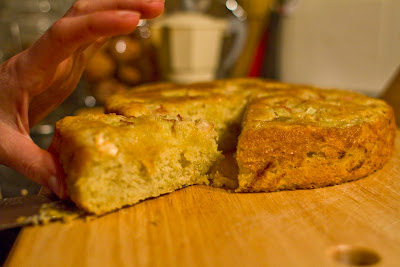Nick loves coconut in all shapes and forms. I tend to be able to take it or leave it, but when it's done right, it's just sublime. I also stocked up on creamed coconut a while ago and love trying out all the recipes it can be used in. Creamed coconut comes in blocks like a solid block of lard, and is very oily. It can be dissolved down and used in place of coconut milk in cooking, or used "as is" in place of butter in baking. It's available in most supermarkets and is cheaper than coconut milk both in terms of unit price and by how far it goes when used in cooking.
Unlike my salted caramel coconut cake, this coconut sponge is quite moist, giving the overall cake a richness that is cut through excellently by the sharp-yet-sweet spiciness of ginger, making this an excellent pairing. The ginger butter cream, using fresh ginger juice, is a little more labour-intensive than other frostings, but have patience, it's not only totally worth it, but will also build up your biceps and triceps if you're old-school like me and don't have a food processor with a grater attachment!
This cake doesn't rise very much, so if you want a tall, altogether more impressive cake, double the quantities of the batter ingredients and bake in four tins instead of two. You should only need to increase the amount of frosting by half to accommodate these changes, to 270g butter, 270g icing sugar and 6tbsp ginger juice.
Coconut & Ginger Cake
Ingredients
Cake batter
3 eggs
80g (just over 3oz) unsalted butter, at room temperature
100g (4oz) creamed coconut, at room temperature
150g (3/4 cup) caster sugar
40g dessicated (ground/shredded) coconut
110g (3/4 cup) plain flour
1½ tsp baking powder
pinch of salt
Frosting
180g (7oz) unsalted butter, at room temperature
180g icing (1 cup confectioner's) sugar
~200g / 8oz ginger (LARGE chunk) - you'll need to squeeze 4tbsp of juice from it.
Method
Preheat the oven to 160°C (electric/fan, 180°C gas, gas mark 4, 320-350°F).
Line two 8 inch sandwich tins with baking parchment, or coat with butter/oil and flour if they are springform tins.
Beat the butter, creamed coconut and sugar together until light and fluffy.
Add the eggs one at a time, alternating with a tablespoon of flour, and beating until just combined.
Gently fold in the remaining ingredients and divide amongst the tins.
Bake in the centre of the oven for approximately 25 minutes, until the centre springs back when pressed, and you can hear a fizzing sound. Cool in the tins for 5-10 minutes before turning out on a wire rack to finish cooling.
To make the buttercream, grate the ginger using a fine grater if possible (the finer the grater the more juice you'll be able to extract).
Squeeze the pulp to extract the juice. If you have a juicer it'll make much lighter work of this process.
Beat the butter and icing (confectioner's) sugar until light and fluffy.
On low speed, beat in 3 tbsp of the ginger juice, 1 tbsp at a time, until just incorporated, being careful not to overmix (or it'll go runny). Have a sneaky taste, and if you can stand more ginger, add the last tablespoon and give it a quick mix. If it's too runny to use straight away, refrigerate for about 30 minutes before sandwiching the cake together and covering with the frosting.
I've topped the cake shown with finely sliced crystallised ginger, which adds an ever stronger ginger kick, but isn't actually necessary.
Use any remaining juice in cooking, or dilute in a smoothie/cocktail. I have a feeling it would work well with lime juice and a mixer, but I'd avoid putting it directly into milky concoctions as it'd probably curdle!
 |
| I *think* they're looking forward to it... |













